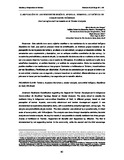Clasificación de los residentes según el apoyo al desarrollo turístico en comunidades indígenas una tipología empírica basada en el cluster analysis
Data
2019-01-02Autor
Chagas, Márcio Marreiro das
Marques Júnior, Sérgio
Da Silva, Victor Hugo
Metadado
Mostrar registro completoResumo
The study aimed to classify the residents living in indigenous communities Eleotérios of Catú, in different groups, based on their perception of tourism impacts, community attachment and tourism development support. It was characterized as exploratory-descriptive study, with a quantitative-analytical approach, survey type. The sample was probabilistic-simple random. The data collection was obtained by a questionnaire, in Likert scale of seven points, with 318 subjects. The analysis was done through descriptive statistics, factorial analysis and cluster analysis. Among the results, it was possible to classify residents into three groups: Averse or indifferent to Tourism, Supporters for Benefits and Supporters by Affection. The first is characterized by not supporting tourism in the community, while the second and the third encourage this activity, differing only in the emphasis on benefits to cluster 2 and affective relationship to the cluster 3. O estudo teve como objetivo classificar os residentes em comunidades indígenas, em processo inicial de turistificação, em grupos distintos baseados em sua percepção de impactos do turismo, apego a comunidade e apoio ao desenvolvimento turístico. Caracteriza-se como exploratório e descritivo, com enfoque analítico quantitativo, do tipo Survey. A amostra foi probabilística, de modo aleatório simples. A coleta de dados foi obtida por formulário, em escala Likert de 07 pontos, conseguindo-se 318 sujeitos. A análise se deu por meio de estatística descritiva, análise fatorial e análise de conglomerados. Dentre os resultados, foi possível classificar os residentes em três grupos: Avessos ao Turismo, Incentivadores por Benefícios e Apoiadores por Afetividade. O primeiro caracterizado por não apoiar o turismo na comunidade, ao passo que o segundo e terceiro incentivam essa atividade, diferindo apenas na ênfase dada aos benefícios para os incentivadores por benefícios e a relação afetiva para os apoiadores por afetividade.




